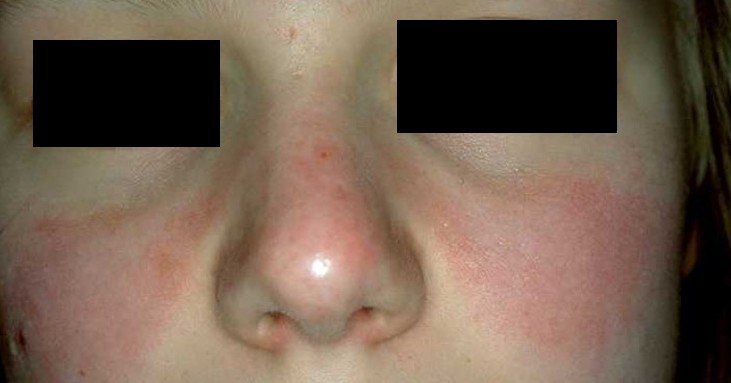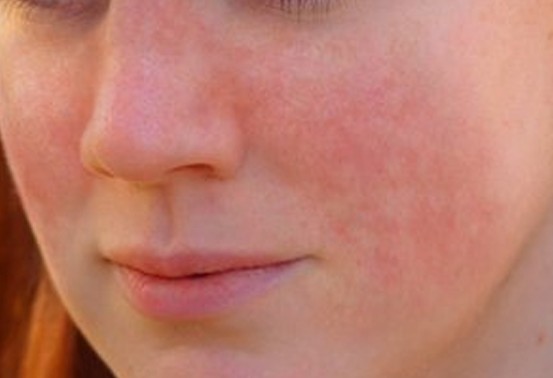Lupus Rash
Last reviewed by Dr. Raj MD on January 12th, 2022.
What is a Lupus Rash?
This medical condition can refer to a skin rash that is common with the autoimmune disease Lupus or a classic rash that will usually appear on your face. In ninety percent of the patients who have lupus will have the rash. The lupus skin rash is more prevalent about people who are Caucasian. Lupus rash is also more prevalent in women than in men.
The rash can appear with any of the four types of lupus which are:
- Systemic Lupus Erythematosus
- Discoid lupus
- Drug-induced Lupus
- Neonatal Lupus
Lupus rash will usually appear on your neck, legs, face, or chest. It can appear on other parts of your body at times. It has also been noticed that the rash mostly appears on any part of your body that is exposed to sunlight.
There are several different forms of lupus rash which can include:
- Classic rash – it is also referred to as a butterfly rash. When you see this rash it has the appearance of a butterfly shape with the “wings” spreading over your cheeks from your nose out. This form is also called acute cutaneous lupus erythematosus.
- Subacute cutaneous lupus erythematosus – this lupus rash does not spread across your face but instead occurs on a single area with a circular shape.
- Bullous lupus erythematosus – this is a severe form of lupus rash that is similar to chicken pox.
Symptoms of Lupus Rash
Because lupus is a chronic disease the symptoms may occur at regular intervals but the lupus rash is persistent. Here are some of the different symptoms you could experience:
- Classic or butterfly rash – this rash will be raised or flat but most time it is flat causing a reddened discoloration of your skin. The rash can be pink or bright red in color. This rash may come and go.
- Subacute cutaneous lupus erythematosus – bumps that could become scaly and will slowly become enlarged and form a circular area on your skin.
- Bullous lupus erythematosus – blisters
- Discoid lupus – the rash associated with this type of lupus is normally disk or oval shaped, slightly raised, and itch a lot. It can appear as patches across your body. When it heals it can leave behind scarring and can also change the pigmentation of the skin in the area affected, making the areas look either darker or lighter than skin surrounding the lupus rash areas,
Having a lupus rash is often a common symptom of both discoid and systemic lupus and is usually the first symptom that a person notices.
Lupus Rash Causes
- Classic or butterfly rash – often occurs after exposure to sunlight.
- Subacute cutaneous lupus erythematosus – this rash is also often a result of sunlight exposure Bullous lupus erythematosus – exposure to sunlight
Although it is not known with certainty exactly what causes lupus rash it is thought at both environmental and genetic factors play a big role in developing this rash. For women who have lupus it appears that the lupus rash appears to become worse just before they start their period. Because of this it is thought that the hormone estrogen may have a part in triggering their lupus rash.
Treatment
At times lupus rash can be hard to treat. There are many different treatments that can be used for lupus rash but what treatment depends on what type of lupus rash you have and how severe the rash is. With some types using oral or injected steroids will help to bring the rash under control while other types can be resolved with topical steroids. Others may require being treated with different types of quinine, which is found in anti-malarial medication.
Here are two types of lupus rash and how you can treat them.
- Classic or butterfly rash – you can help heal this type by avoiding exposure to the sun. Once it has healed it can leave behind a discoloration on your skin but it all depends on how long you had the lupus rash.
- Subacute cutaneous lupus erythematosus – avoid exposure to the sunlight as much as you can.
There are many different treatments that can be used for lupus rash but what treatment depends on what type of lupus rash you have and how severe the rash is. With some types using oral or injected steroids will help to bring the rash under control. Using oral treatments can take several months to work but when the treatment is finished in most cases the results are positive. If your physician suggests injections of steroids you need to know that there are several side effects with this treatment and should be considered one of the last treatment options.
Other types can be resolved with topical steroids. Others may require being treated with different types of quinine, which is found in anti-malarial medication. If you have just a mild rash you can treat it with hydrocortisone but in severe cases you should treat it with betamethasone for severe cases. If you catch the lupus rash in the early stages topical treatment is usually a successful form of treatment.
Because there are many types of lupus rash with different symptoms and treatments they all share some common forms of treatment, which can include:
- Not exposing your skin to intense sunlight or fluorescent lights.
- Use a good sunscreen lotion
- Make sure that you cover all parts of your body that are most likely to affected by the sun and cause the lupus rash



